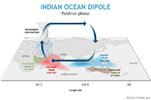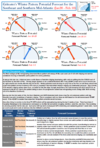Webberweather53
Meteorologist
It has inched a lot closer towards phase 3, esp near the beginning of that period.
View attachment 140362
The reason for the loop-de-loop/the slowing of the MJO over the Indian Ocean recently has a lot to do with the recent collapse of the positive phase of the Indian Ocean Dipole (+IOD). The IOD has a huge impact on the amount and distribution of convection over the Indian Ocean and Maritime Continent. The positive phase, w/ a cold tongue of upwelled water adjacent to Sumatra, suppresses convection over the eastern Indian Ocean and Maritime Continent.
You can basically think of deep convection like the brakes of the MJO. When the MJO moves through areas of the global tropics that are convectively active, it slows down, whereas the MJO speeds up through areas that have less convection.
The real reasons this connection between convection - MJO phase speed exists actually is quite complicated, and I won’t elaborate further here, but you get the idea.
So in essence, this kind of abrupt basic state change we saw to the IOD (going from positive to neutral) triggered a major change in how the MJO propagated through this part of the globe, in this case, actually slowing it down. It’s not something that’s easy for models to pick up on








